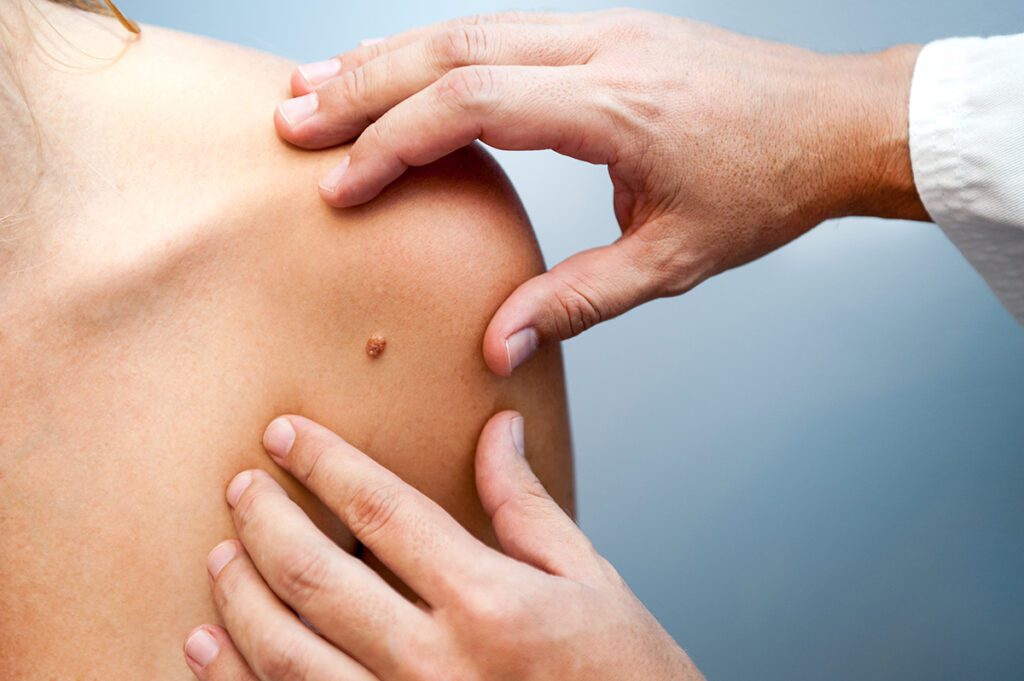Most Skin Cancer Is Preventable; Early Precautions Pay Off Later
by TIM CRAIG
Tom and Ariana Glennon know about the sun. From being stationed out in the South Pacific to making a life in Winter Haven, the pair’s experience with the sun’s rays has evolved.
“When we were younger, there was no thought about sunscreen,” says Ariana, starting the sentence.
“You just got burnt,” says Tom, finishing the thought.
Things changed as the couple got older. While Tom has had one skin cancer removed, most of the experience has come from Ariana.
“I think I’ve had 20 of the surgeries, so I’ve had a lot,” she says. “Things changed once I got into my 60s and all of a sudden, these cancers started taking off and growing fast.”
The surgeries culminated in a bout that required a skin graft.
“Now if I see something popping up, I know I need to see someone right away,” she says. “I don’t want another skin graft.”
The couple’s experience with skin cancer is not uncommon, particularly for Florida. The Sunshine State ranked second behind California in the number of new melanoma of the skin cases in 2017, the latest year reported by the Centers for Disease Control and Prevention. Of the 5 million new cases of skin cancer diagnosed each year, roughly 85 percent are associated with exposure to ultraviolet radiation from the sun.
“Anyone can get skin cancer. Regardless of skin color or background,” says Medical Director of Florida Dermatology and Skin Cancer Centers, Dr. K. Wade Foster, where the Glennons were treated.
Florida Dermatology and Skin Cancer Centers provides an array of dermatology and skin care services, including diagnosing and treating skin cancers with the latest technological options. Foster is fellowship-trained in Mohs surgery, a technique for most types of skin cancers, which leaves patients with minimal scarring or risk.
With the sun looming large and summer on the doorstep, it may be time for a refresher of what the sun can do to the body.
“Fortunately, skin cancer is one of the most preventable forms of cancer and we can lessen our chances by taking a few important measures,” says Foster.
The first thing he recommends is to regularly check yourself and learn what to look for. To regularly perform a self-exam, look in the mirror for any new, unusual or changing areas. If you find something, report it to your dermatologists right away. Areas of the skin that are exposed to the sun are more prone to develop moles, so it may be a good idea to set up an annual exam to look over all areas of the body, including the scalp, neck and back.
To help guide you while performing the self-examination, the American Academy of Dermatology has developed a process called the ABCDEs of skin cancer:
- Asymmetry. If one half of the mole looks different from the other half, this may be an area of interest;
- Border. If the mole has an irregular or poorly defined border, take note;
- Color. If the mole’s color varies from one area to the next — including shades of tan, brown, or black; or areas of white, red, or blue, these may be indications of a skin cancer;
- Diameter. The area may be greater than six millimeters, or about the side of a pencil eraser. Smaller areas can also be diagnosed;
- Evolving. The mole or lesion may change shape, size, and color over time.
Other things people can actively do to help minimize the damage of the sun’s UV rays, according to Dr. Foster, include covering up and avoiding dangerous practices.
Covering up not only includes sunscreen — which should be water resistant and at an SPF of 30 or higher, according to Foster — but also wearing clothing. There are a lot of companies that make long-sleeved and lightweight shirts, pants, hats and sunglasses with UV protection.
Avoidance also includes tanning beds — which may cause upwards of 400,000 cases of skin cancer in the U.S. each year, according to Florida Dermatology and Skin Cancer Centers. Luckily, there are sunless lotions and spray-tanning services that can achieve the same glow. Avoidance also includes trying to stay in the shade between the hours of 10 a.m. and 2 p.m., when the sun’s UV rays are the strongest.
Foster says that melanoma will affect 1 in 27 men and 1 in 40 women in their lifetime. In fact, if a person has had more than five sunburns the risk of melanoma is doubled. However, the five-year survival rate for people whose melanoma is detected and treated is 99 percent.
“Fortunately, skin cancer treatment, specifically melanoma, has a very favorable outcome since, if it is detected early, it’s almost always treatable,” he says.
The key, according to Ariana Glennon, is for the patient to take charge.
“Don’t be slack,” she says. “Get a habit going of taking care of your skin.”
